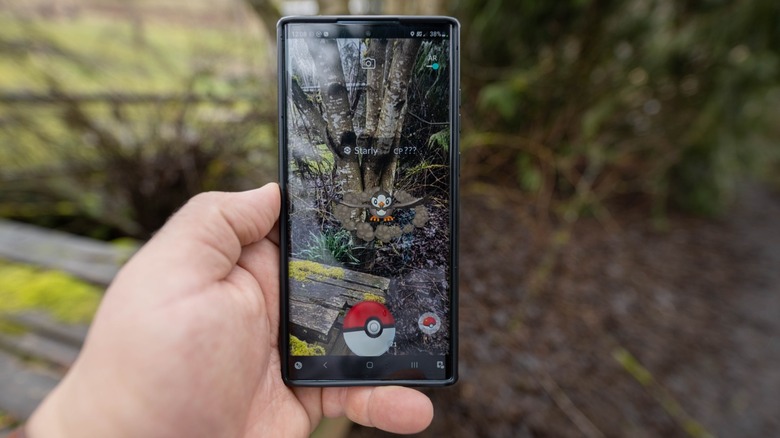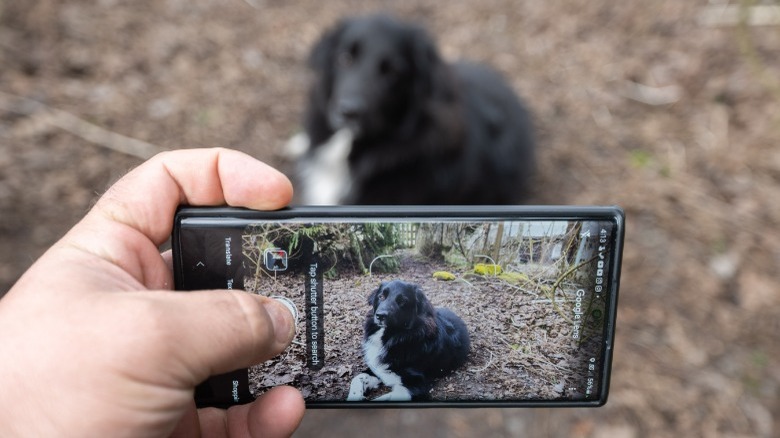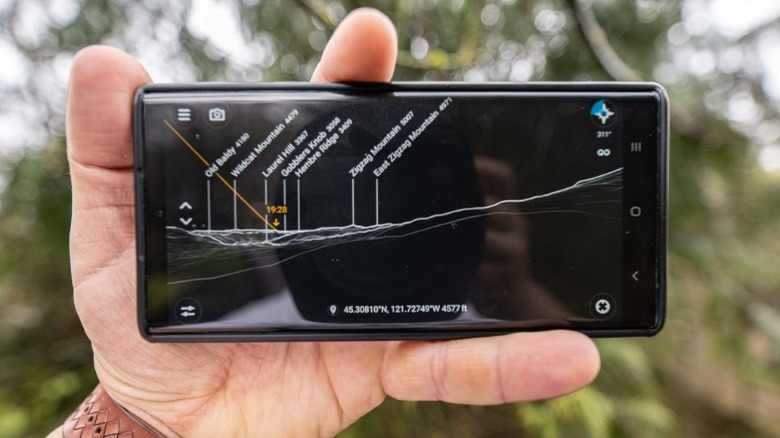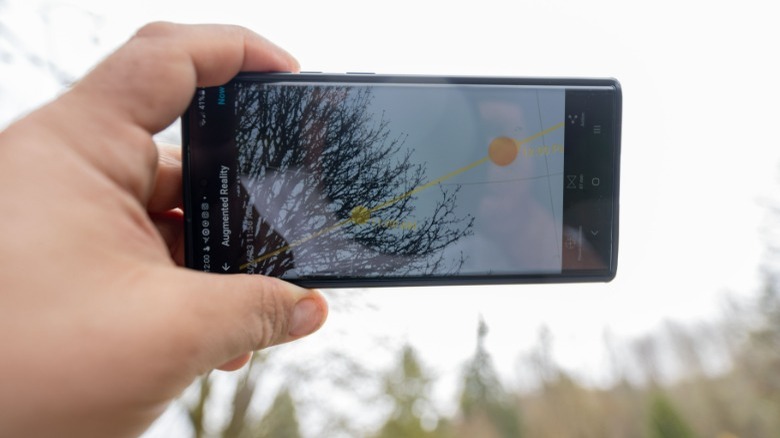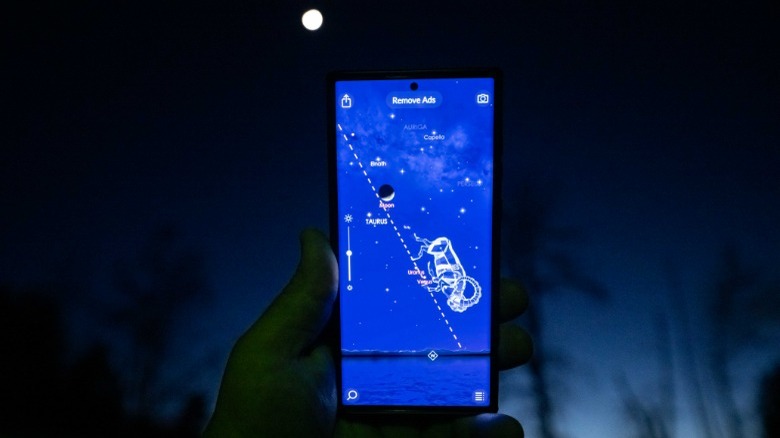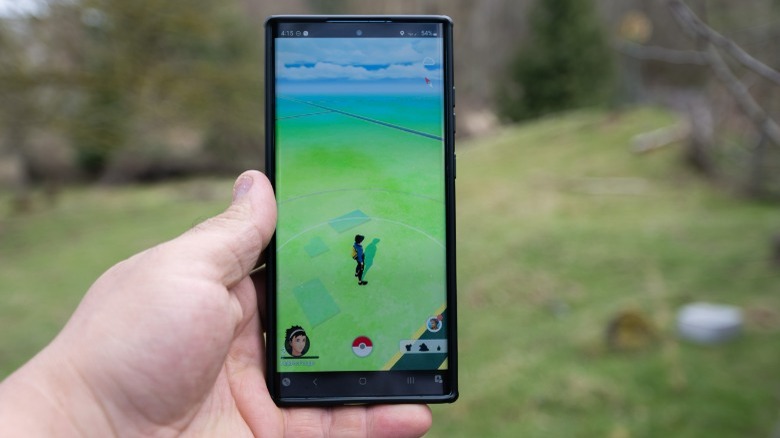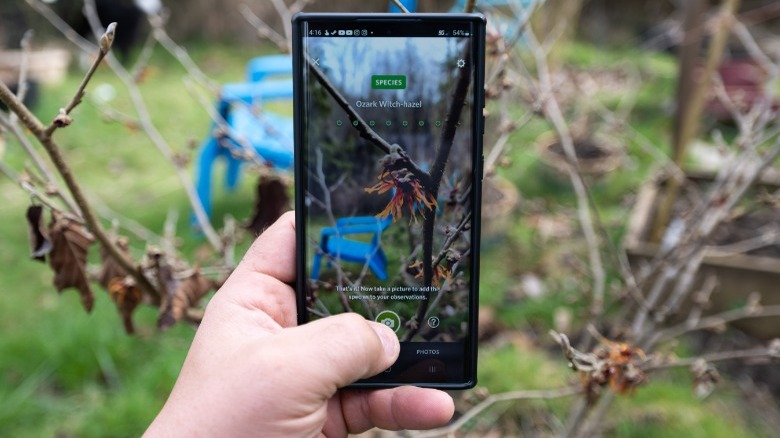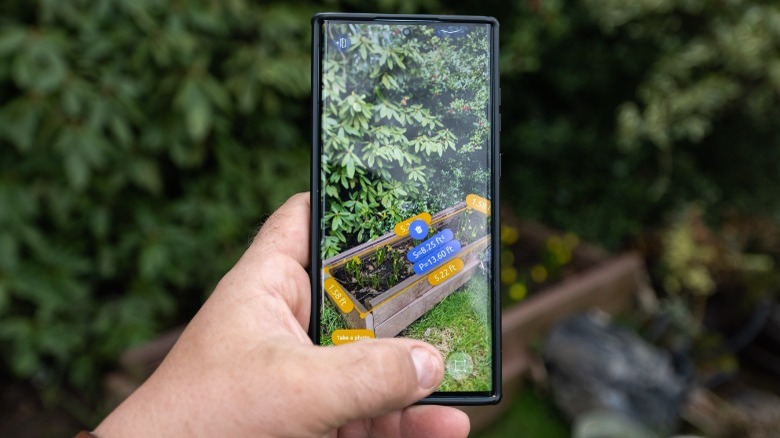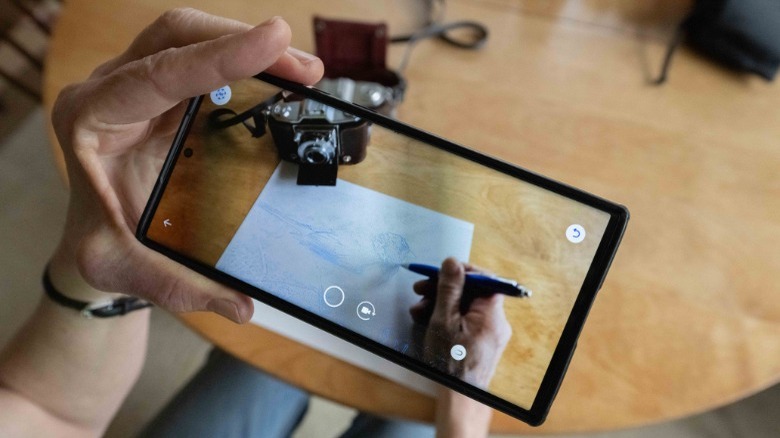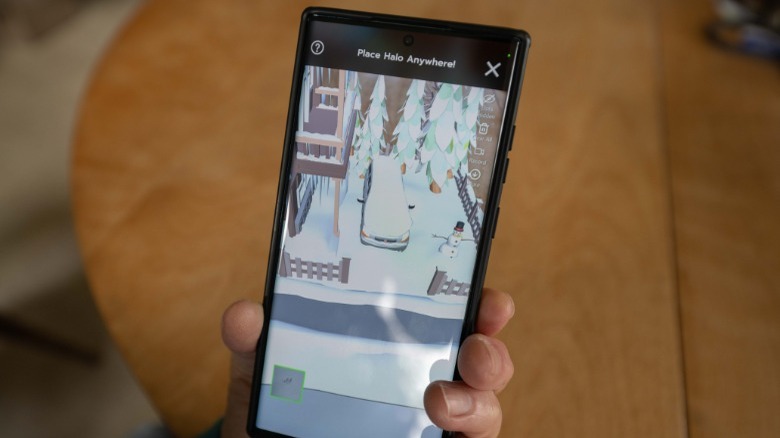The Coolest Ways To Use Augmented Reality On Your Android Phone
We may receive a commission on purchases made from links.
While augmented reality (AR) may seem like sci-fi jargon, and associated with expensive, experimental devices like the Microsoft Hololens, in fact, augmented reality is widely available, and has been for some time. If you've ever played "Pokémon Go," you've experienced augmented reality. To put it as plainly as possible, augmented reality is an experience in which you interact with digital objects in the real world through an interface. This includes everything from games like "Pokémon Go" to the AR Ruler app, which allows you to measure objects or even whole rooms using your phone.
It's important to note that your mileage may vary with augmented reality apps, and what's available today may not exist tomorrow, or be functional on every version of Android. For example, the intriguing AR graffiti app WallaMe is no longer available on the Play Store, and other augmented reality apps such as "Angry Birds: Isle of Pigs" and Civilisations AR don't currently work on Android 12.
While some apps such as Google Lens are completely free, others such as PhotoPills charge for access to the app. Depending on your needs, it can be worth the money to obtain the unique tools and entertainment that augmented reality offers.
Google Lens
A do-it-all augmented reality app, Google Lens is probably already installed on your Android phone, and once you start using it you'll wonder how you ever survived without it. Lens is a remarkably intuitive app to use — just point it at something and press the search button, or select an image from your gallery, and then choose from a variety of options for what you want Lens to do.
Lens can translate text, copy printed or handwritten text, or find visual matches for practically anything. Want to compare prices online for an item you find in the store, identify a plant or animal, look up research for a homework question, or find info on a location? Google Lens is eerily accurate and will find exactly what you're looking for in almost any scenario.
The only serious limitation of Google Lens is that it's dependent on the internet. If you're somewhere without a decent connection, Lens simply won't work. However, considering how widespread access to strong wireless connections has become, this isn't a major limitation outside remote rural and wilderness areas.
PeakFinder
This is a must-have app for outdoors enthusiasts. Plus, it's a lot of fun if you're just on vacation and want to get a better idea of the geography around you. PeakFinder shows you a three-dimensional view of your surroundings and identifies various mountains within your line of sight. Combined with a map, it's a great route-finding tool that can help with navigation, particularly in low-visibility situations.
A great example of this low-visibility route-finding functionality would be in a scenario where you're surrounded by dense trees or thick fog. In such a situation, it can be difficult to get your bearings. With PeakFinder, you essentially gain X-ray vision to see the landscape without obstructions. As it also marks the augmented reality view through your phone with the names of the hills and mountains around you, it's easy to cross-reference such landmarks with a physical map.
While it's true that GPS apps such as Gaia GPS can show your location and the landscape around you, PeakFinders augmented reality presentation is both useful and fun. It's available for $4.99 on the Google Play Store.
PhotoPills
The ultimate photography assistant, PhotoPills offers a wealth of information and tools to help you plan your photo shoots and capture the best images possible. PhotoPills contains a host of functions, including augmented reality visualizations of the position of the sun and moon throughout the day, and depth of field calculations. It's extremely useful for astrophotographers as it shows the movement of the stars, the location of meteor showers, and the milky way. Overall, PhotoPills takes a lot of guesswork out of photography through its various augmented reality features.
Additionally, PhotoPills can help you calculate timelapse shooting parameters, and plan when and how to shoot at various locations based on the position of the sun, moon, and other factors. Video tutorials are also available, as well as how-to articles and other helpful info.
PhotoPills is a paid app that will set you back $10.99, but while that might seem steep if you're used to using free apps, the lack of ads and the impressive functionality are definitely worth the one-time upfront cost.
Star Walk 2
For any astronomy enthusiast, Star Walk 2 is extremely handy. It presents a gorgeous augmented reality view of various constellations, planets, and other extraterrestrial objects. The view through your phone while using Star Walk 2 depicts you standing on the translucent surface of a lake, with the visible sky above full of everything currently visible to you. Below the surface of the virtual lake lies what's obscured by the surface of the earth.
Constellations light up as you look at them, showing visualizations of the legendary figures that various groupings of stars are associated with. Star Walk 2 also shows other objects, including things like comets, satellites, and meteor showers. Some objects and features are hidden behind a paywall and can be accessed individually for $0.99 each, and you can pay $2.99 to block ads, or you can pay $5.99 for everything bundled together, which represents a slight discount. Alternatively, a $0.99 monthly subscription is available, though this doesn't make a lot of sense if you only intend to use the app for a very limited period of time. The free, ad-supported version of the app is great, so don't feel pressured to spend money.
Star Walk 2 is an incredibly well-designed augmented reality experience and is a must-have app for amateur astronomers.
Pokémon Go
Despite being several years old, "Pokémon Go" remains popular and is easily the most recognizable augmented reality game. At its core, "Pokémon Go" is a simple enough concept, which is part of what turned it into a global phenomenon and maintained its popularity for so long. Players travel the real world, and using the app, search for Pokémon that are displayed in front of them through the camera lens on their phone. As in most Pokémon experiences, the goal is to catch them all, and here that's accomplished by flicking Poké balls at them on your phone. Practice is needed to toss the Poké balls just right for a higher chance of catching Pokémon, and berries can be used to further increase your odds.
Catching Pokémon is just the beginning of what you can do in "Pokémon Go;" you can visit Poké stops located around the real world to get free items, or you can visit gyms to participate in Pokémon battles and earn in-game currency. You can also battle against other people, or participate in raids where multiple people need to work together in difficult battles.
"Pokémon Go" has evolved over the years from a very basic collect-them-all concept to the fully fleshed-out real-world augmented reality game it is today.
Seek
While Google Lens is very capable at plant and animal ID, Seek is a dedicated application for that purpose. Seek was developed by iNaturalist, a joint initiative by the California Academy of Sciences and National Geographic. The app scans and identifies whatever natural object you point it at with a fairly high degree of accuracy. It's a great tool for teaching and is particularly aimed at getting kids engaged in learning about nature. However, its usefulness is not at all restricted to younger age demographics — it's a useful app for anyone who enjoys spending time outdoors.
In addition to the augmented reality identification feature, Seek allows you to journal the various plants and animals you encounter through the app to earn badges that gamify the experience of exploring the natural world. The accuracy of Seek is constantly improving, as it's fueled by user input. As more people use the app and record their own observations, it grows increasingly accurate at identifying different species.
AR Ruer
This is a really polished and versatile augmented reality measuring tool that takes a lot of the work out of calculating the size of various objects. In addition to simple measurement of distances, AR Ruler enables you to calculate volume and visualize different shapes and sizes of objects. The autodetect feature is particularly handy, as it allows you to quickly get rough measurements of objects without needing to manually measure them. Once you've measured something with AR Ruler, you can take a picture, and the app can remember measurements so that they don't just disappear and you don't continually need to re-measure.
The limitation is that AR Ruler isn't quite as reliable as a physical measuring tape, so it's really more of a tool for quickly getting a rough idea of sizes and distances. There's also a companion app called AR Plan 3D, which is designed to quickly measure and plan rooms. The biggest downsides to AR Ruler is that it needs a lot of light to function well, and it aggressively pushes users to pay for an eye-watering $19.99 per month subscription; if you don't subscribe, it bombards you with ads.
Alternatively, there are some other great augmented reality measuring apps available, with Quick Measure on the Samsung Galaxy store being a particularly good free option, although it lacks AR Ruler's more advanced features.
Sketchar
If you want to learn how to draw, Sketchar is an amazing augmented reality app that can get you started by providing a guided experience that includes both preloaded drawings and the ability to create new guides from your own images processed through the app.
Sketchar is a versatile app with a lot of potential and is worth using even if you don't use its augmented reality features. You can simply use it to create and share sketches, either freeform or with various guided lessons, and you can post your creations in the Sketchar community. The timelapse recording functionality is particularly great for this purpose, and the app is ideal for generating engaging content for social media.
The augmented reality component of Sketchar comes in two parts, one is that you can capture a photo, and Sketchar will analyze that photo to render a drawing guide. The second is that Sketchar can display both your own rendered drawing guide, or one of the many available pre-made drawing guides, overlayed on top of the video from your phone's camera. This means that you can use the app as a guide for real-world art, and simultaneously record your progress as a timelapse. It works surprisingly well, though a tripod makes the experience a lot better.
The caveat is that Sketchar is really pricey, costing $7.99 per week, $14.99 per month, or $69.99 per year. This pricing structure is clearly designed to get you to pay for a full year, as the weekly and monthly prices are just ridiculous.
Halo AR
Designed to facilitate widespread augmented reality integration into real-world scenarios, Halo AR allows users to place digital objects in the physical world for anyone with the app to view. This ranges from 2D text, images, audio, and videos, to holographic 3D models. Simply snap a photo of something, then associate that image with a digital item of your choosing.
A publisher might publish a magazine where readers could scan pages so that relevant videos play alongside the text, a teacher could conjure a three-dimensional model of the solar system in the classroom, or a museum could provide users with extra info on physical displays. You could also use it to provide contextual audio to aid those who speak/read a different language or are visually impaired. The practical applications are fascinating, and it's fun to play around with. Plonking down a robot or a miniature town on your kitchen table and then looking around at it through your phone is a fascinating novelty.
